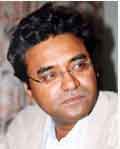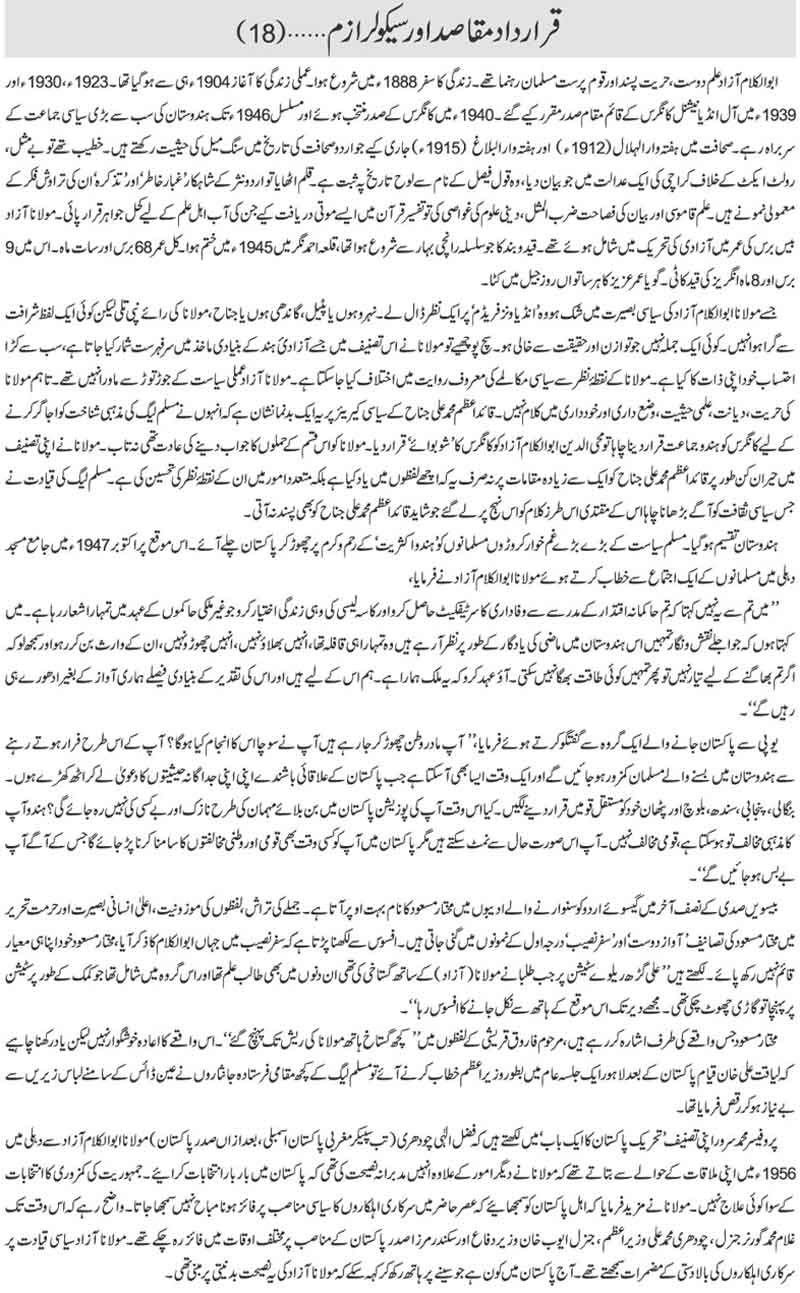 The founder of
Pakistan, Mohammad Ali Jinnah, wanted a separate country for Muslims but his
political upbringing in a pluralist society prevented him from declaring
Pakistan an Islamic state. Contrary to the general perception in India, Mr
Jinnah was arguably a secular and liberal Muslim who wanted a Pakistan where all
citizens would be equal in the eyes of the constitution irrespective of their
religion, caste or creed. But leaders like Liaqat Ali Khan and power hungry
opportunistic religious leaders wanted it to be otherwise. In this beautifully
written series titled, "Objectives Resolution and Secularism", Mr Wajahat Masood
delves deep into history to find out how Jinnah's dream of a secular and
democratic Pakistan was shattered. -– Editor
The founder of
Pakistan, Mohammad Ali Jinnah, wanted a separate country for Muslims but his
political upbringing in a pluralist society prevented him from declaring
Pakistan an Islamic state. Contrary to the general perception in India, Mr
Jinnah was arguably a secular and liberal Muslim who wanted a Pakistan where all
citizens would be equal in the eyes of the constitution irrespective of their
religion, caste or creed. But leaders like Liaqat Ali Khan and power hungry
opportunistic religious leaders wanted it to be otherwise. In this beautifully
written series titled, "Objectives Resolution and Secularism", Mr Wajahat Masood
delves deep into history to find out how Jinnah's dream of a secular and
democratic Pakistan was shattered. -– Editor
“Once again I
stress to all the Muslims to co-operate with the government and its personnel
against the violators of law, traitors and conspirators who are responsible for
this anarchy to save the Hindu neighbours. There will be rule of Constitutional
government, not of the traitors, conspirators and unruly mob in Pakistan. The
government of Pakistan will take every possible action against such criminals
and they will be dealt with an iron hand. My full sympathies are with the
Hindus, most of whom were provoked by propaganda. In fact, the main purpose was
to drive them out of Sindh. As a result, many Hindus had to suffer. The people
who brought Sikhs to Karachi without informing the concerned officials, the
District Magistrate and the police and lodged them in the gurudwara could not
been tracked as yet, but a full inquiry will be conducted into the
matter.”—Wajahat Masood

By Wajahat
Masood
(Translated from Urdu by Sohail Arshad)
Let’s have a look at the
proportion of Muslim and non-Muslim (Hindu-Sikh) population in the affected
areas, according to the census of 1941:
Area
Muslim %
Non-Muslim %
Rawalpindi 80 18.67
Campbellpur 90.42
9.36
Mianwali 86.16
13.76
Jhelum
89.42
10.41
Sargodha 83.68
14.88
Kohat
91.99
8.10
Gujarat
85.58
14.2
Multan
78.1
20.52
Gojranwala 70.45
22.70
Banun
87.6
12.90
Sialkot
62.09
31.12
Lahore
60.62
35.9
Peshawar 90.34
9.65
Marwan 95.46
4.52
Dera Ismail Khan 85.78 14.21
By merely having a bird’s eye
view of the religious division of the population in the affected areas, it can
be understood which community had the possibility of having an upper hand in
case of riots. It should not be surprising then that while giving shape to the
Punjab Boundary Force with a view to the possible deterioration of the law and
order situation in the end of July 1947, these areas were not brought under
consideration because the non-Muslim population there had almost been wiped out
or had migrated.
It would not be unrealistic to
say that after the formation of Pakistan, no one from the Muslim League
leadership except Jinnah made any serious effort to retain Hindu-Sikh population
in Pakistan and protect them. Liaqat Ali Khan was trying to consolidate his electoral base by bringing more and more
Muslims from the Muslim-minority areas. The Muslim League leadership was
impatiently waiting to grab the urban properties, businesses, costly assets,
agricultural land and jobs of the non-Muslims by driving them out.
Take the example of the Sindh
province where 36% of the agricultural land was pledged to the Hindu population.
Interestingly, not a single statement of any religious peshwa condemning the
incidents of killing, plundering, arson and rape came into light during the
riots spanning several months. Even if a voice was heard, it was of the
flag-bearer of the Hindu-Muslim unity, Md Ali Jinnah who had long been declared
kafir (infidel) by the religious peshwas.
Ghalib’s friend and Delhi’s
renowned religious leader in the 19th century Mufti Sadruddin had rightly said:
Kamil us firqa-e-zahad se utha
na koi
Kuchh huye to yehi
rindaan-e-qadah khwar huye
( No one but no one graduated
among the class of the self-righteous,
Only some of the knaves got the
honour)
On the occasion of his tour of
the riots-affected areas on January 9, 1948, Qaid-e-Azam Md Ali Jinnah had
issued a message titled ‘Hindu humsayon ko bachao’ (Save the Hindu neighbours)
to the Pakistani citizens:
“Once again I stress to all the
Muslims to co-operate with the government and its personnel against the
violators of law, traitors and conspirators who are responsible for this anarchy
to save the Hindu neighbours. There will be rule of Constitutional government,
not of the traitors, conspirators and unruly mob in Pakistan. The government of
Pakistan will take every possible action against such criminals and they will be
dealt with an iron hand. My full sympathies are with the Hindus, most of whom
were provoked by propaganda. In fact, the main purpose was to drive them out of
Sindh. As a result, many Hindus had to suffer. The people who brought Sikhs to
Karachi without informing the concerned officials, the District Magistrate and
the police and lodged them in the gurudwara could not be tracked as yet, but a
full inquiry will be conducted into the matter.”
Was this a political statement
of Qaid-e-Azam Md Ali Jinnah? Was he resorting to the same ‘hollow rhetoric’ of
the politicians that has subjected the political process and the politicians to
common disdain for decades in the country?
Let’s take the testimony of the
Lieutenant General ( retd) Gul Hasan on
this issue. Gul Hasan was the ADC to Qaid-e-Azam and was also the Chief of the
Pakistani Army for a few months after the separation of the East
Pakistan.
Let me mention here that Gul
Hasan was one of the architects of the dominance of the army over the political
leadership, and whenever he mentions any politician in his book, his typical
army tone betrays scorn and contempt. In his book, ‘Akhri Commander-in-Chief’
(The last Commander-in-Chief) he writes:
“It was during my last days of
my services as ADC that the communal riots broke out in Karachi. In those days
Qaid-e-Azam looked very worried. One day he called me and asked if I had sent
food to one of my Hindu friends. He was acquainted with his father. Replying in
the affirmative, I told him that my friend’s house was located exactly at the
same place on Bandar Road which is the centre of the riots. I believe that he
and his servants will not have the courage to come out of the house. I further
told Qaid-e-Azam that I had been using the Governor General’s car and had given
money to the driver from my own pocket to buy essential things. I also informed
him of the fact that I had sent all the items to my friend’s house when there
was curfew at night.” He looked into my eyes and said, “I am proud of you.
Whenever the people of Pakistan are in trouble, we should help
them.”
You can see here, Qaid-e-Azam
said,” Whenever the people of Pakistan are in trouble, we should help them.’ He
did not say, “Whenever the Muslims of Pakistan are in trouble, we should help
them.” After the formation of Pakistan, in Qaid-e-Azam’s view the first and the
last identity of a Pakistani citizen was his being a Pakistani, rather than his
belief.
It is not that during this
period of anarchy, the rank and file of the politicians, government officials
and common people were totally devoid of such elements who held on to the
principles of humanity. In Amritsar alone, eight non-Muslim communist activists
laid down their lives while protecting the Muslim citizens. Hayat Ahmad Khan was
a highly responsile, respected and sophisticated citizen of Pakistan. He had
rendered selfless services to the classical music through Pakistan Musical
Conference in Pakistan for a half century. I would rather say that he sacrificed
everything for music’s sake.
Having passed his M.A. in
English from the Government College, Lahore in 1947, he was ushering in his
practical life. His description of Lahore of 1947 in his biographical sketch of
Agha Babur is worth reading. It shows that humanity had not completely perished.
It had just happened that the evil forces had had a field day
temporarily.





 Sultan Shahin
Sultan Shahin


0 comments:
Post a Comment